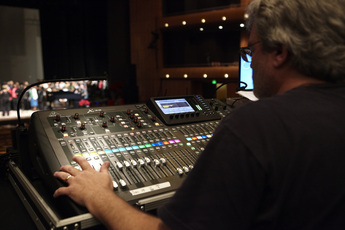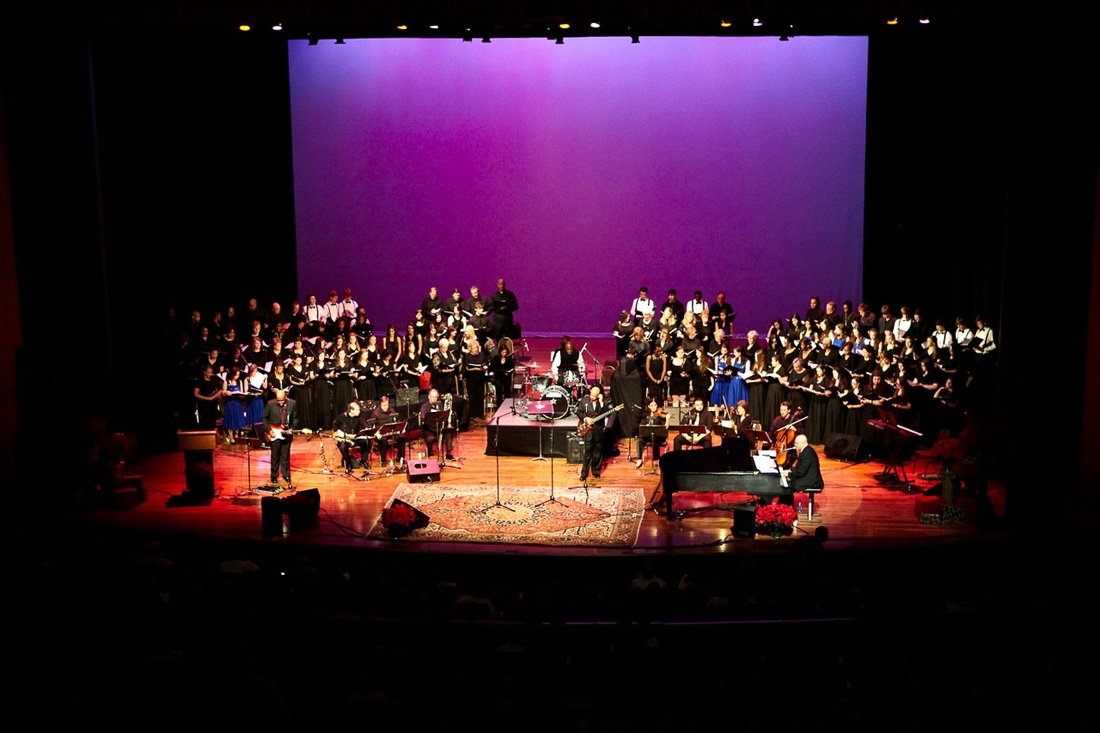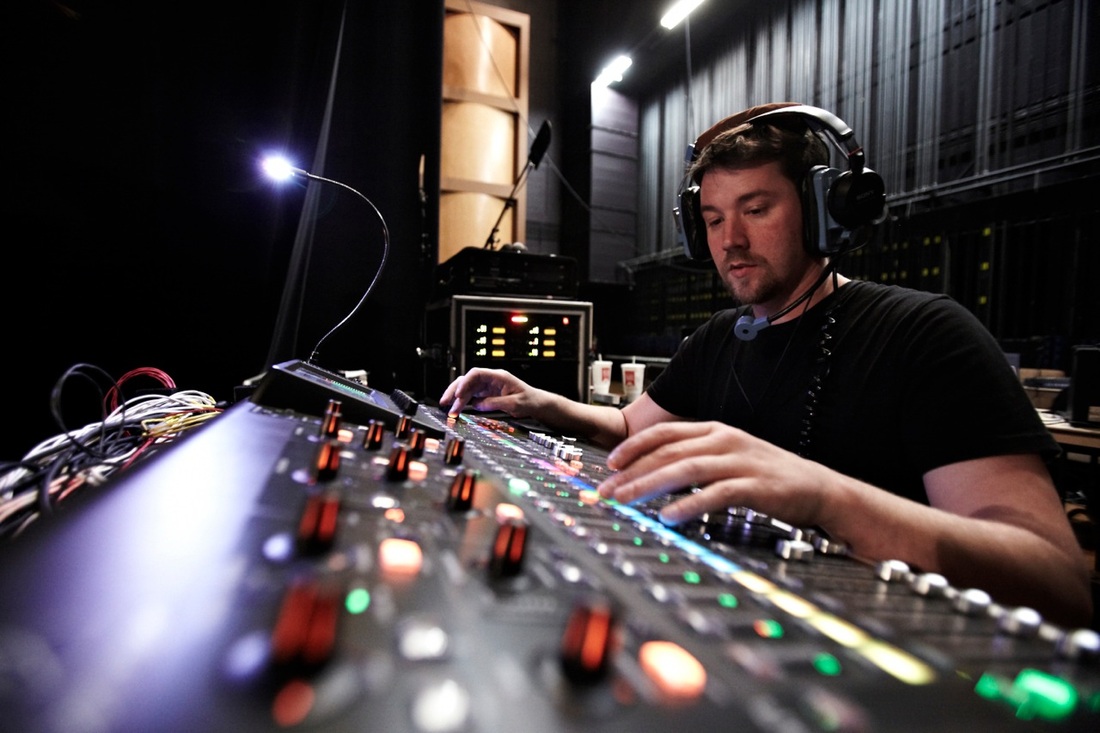BEHRINGER X32 SCORES THREE-WAY TIE IN MEMPHIS
January 22, 2013 - Article As Released by MUSIC GROUP
TechLifeLine Productions, based in Lakeland, TN has purchased a total of four BEHRINGER X32 Digital Mixing Consoles and put them into service in the course of just three months. Their most recent event was for Christian artist John Angotti, who held his annual Christmas concert at the Cannon Center for the Performing Arts in downtown Memphis. This concert featured a wide-ranging program of Christmas music with gospel, hip-hop and top 40 performers in addition to John Angotti. John's show and stage brought together groups from local Catholic high schools, a 140-member choir, a small orchestra and a four-piece band. Not to mention a live broadcast seen around the world on http://www.mycatholicvoice.com to a potential audience of 1.8 million viewers. To ensure that all of the audio elements worked seamlessly, it was decided by TechLifeLine President, Kiley Butler, to utilize the BEHRINGER X32. Three consoles were brought in for FOH, monitors and broadcast. Butler commented, "The real benefit of the triple X32 solution was the ability to split and route all of the signals using only the digital routing inside the X32. Utilizing the X-Control for our laptops also greatly sped up the process." The center point for the production's signal flow was at the X32 being used for monitors. Monitor engineer Brandon Armbruster set his console as the master clock for the other two consoles. Using the AES50 routing tabs (A and B), all 32 analog inputs were sent to the FOH and broadcast boards. A CAT5 connection was then made from monitor to FOH. Four mix signals-Main L, Main R plus two matrices were sent back to the Monitor board via the X32 P16 digital outputs thus eliminating the need for a send snake from FOH to the power amps located backstage. Finally, the AES50A on the broadcast audio console was connected to the AES50B on the monitor console and it was show time. Tom Browning, who was the designer of the routing structure and also served as the broadcast engineer, was pleased with the results and said, "The BEHRINGER X32 presented an end-to-end solution that kept all signals in the digital realm, from their entry point at the monitor console until their final analog output. The incredible depth of routing built into these consoles is impressive." Article Published At: ProSoundNetwork.com Technologies For Worship Magazine Soundforums.net AudioProInternational.com LifePR.de (Germany) |
TechLifeLine Designs a 3-way Split Using three X-32’s

Memphis, TN - Original TechLifeLine Article Written By Tom Browning
Christian music artist John Angotti recently held his annual Christmas concert at the Cannon Center for the Performing Arts, home of the Memphis Symphony Orchestra in downtown Memphis, TN. The concert featured a rich variety of Christmas music from backgrounds as diverse as gospel and hip hop to top 40 popular music. Along with John on stage were groups from local Catholic High Schools, a 140 member choir, a small orchestra and a talented four piece band.
This concert was extra special as it was the inaugural live broadcast around the world to military installations and to the public on mycatholicvoice.com with a potential audience of 1.8 million viewers.
John approached TechLifeLine to handle all of the audio elements of the program and broadcast. To ensure the audio solution met the complex needs of the program, TechLifeLine President Kiley Butler and team chose to utilize three Behringer X-32 consoles in a complex configuration. The team configured the three consoles to each perform a specific function: one for Monitors, one for Front of House and one dedicated to mix broadcast audio. The real benefit to the triple X-32 solution was the ability to split and route all the necessary signals using only the digital routing available inside the X-32 console.
As a part of the pre-production, the team worked over several days to refine the input lists and routing for the consoles. Setting up the consoles in the workshop to ensure the all of the routing was done correctly. “The incredible depth of routing flexibility built into these consoles is impressive” said Tom Browning, designer of the routing structure and Broadcast Audio engineer. “The power of using the X-Control application to set-up the routing saved an incredible amount of time” he added.
Onsite, the first step in the process was for monitor engineer Brandon Armbruster to set-up his console. This console was the entry point for all of the analog signals on stage. Three sub-snakes were routed to the various areas of the large theater’s stage allowing short cable runs to the various input signals. The monitor console was setup to mix 3 stereo in-ear sets as well as seven on-stage monitor wedge mixes.
The monitor console was also set to be the master clock for the other two consoles. Using the AES50 routing tabs, internal routing on the monitor console sent all 32 analog inputs to both of the other consoles: FOH using the AES50A port and the Broadcast Audio console over AES50B.
The CAT5 connection from the Monitor console was connected to the AES50A port on the back of the FOH console. Using the channel processing routing tab, internal routing at the FOH console was set so that the AES50A channels from monitor world were presented on channels 1 thru 32 on the FOH console.. But inputs at FOH is only half the story. Using the impressive flexibility of the P16 digital outputs, 4 mix signals were routed back out of the AES50A port to the monitor console: Main L and Main R and two Matrix outputs. This eliminated the need for a send snake to be run from FOH back to the amps backstage. Back at the monitor desk, those digital inputs from the FOH console were routed using the channel processing tab inside the Monitor console, to present on AUX 1-4. Using the analog output routing, these signals were further routed directly to analog outputs 13-16. Setting these up as Pre-EQ ensured that no additional gain structure or adjustment needed (or could) to be made at the monitor console.
Finally, the AES50A on the Broadcast audio console was connected to the AES50B on the Monitor console. Again using the channel processing tab on the broadcast desk, all 32 inputs were presented on all 32 mix channels. Two additional inputs for audience response mics (which were not needed on the other two consoles) were placed directly into this console on analog inputs 1 and 2. Using the flexibility of the individual channel configuration, these two inputs (internally called Aux1 and Aux 2) were presented on channels 31 and 32, and the video playback channels (which were 31-32 on the other two consoles) were configured to present on Aux1 and Aux2 faders on the broadcast console.
This presented an end to end solution that kept all signals in the digital realm from their entry point into the monitor console until their final analog output. This also eliminated what would have been a very expensive 3-way analog split snake; not to mention the additional labor needed to set and strike all that copper.
Each of the consoles operated incredibly well, freed to do their specified task. Even with minimal communication and an almost non-existent sound-check covering multiple acts, the team was able to quickly dial-in gain structure and EQ separately on all three desks, with each tailored to the specific needs of their application.
At the end of the night, the consoles performed exactly as planned. Only minimal tweaks were needed to the routing on-site to account for last minute changes in the program content.. “We just plugged them in and it worked!” said Tom Briggs, Director of Production for TechLifeLine. Kiley Butler echoed those remarks, “We no longer use our Japanese digital consoles because the combination of the X32‘s audio quality, flexibility and value is truly a game changer.”
For more information about TechLifeLine: www.techlifelineproductions.com
All photos taken by Josh Jacobs and are copyrighted by AreaOne/TechLifeLine
To watch the John Angotti Christmas show: http://www.mycatholicvoice.com/media?keyword=JALTZFEAT&search_in=query
Christian music artist John Angotti recently held his annual Christmas concert at the Cannon Center for the Performing Arts, home of the Memphis Symphony Orchestra in downtown Memphis, TN. The concert featured a rich variety of Christmas music from backgrounds as diverse as gospel and hip hop to top 40 popular music. Along with John on stage were groups from local Catholic High Schools, a 140 member choir, a small orchestra and a talented four piece band.
This concert was extra special as it was the inaugural live broadcast around the world to military installations and to the public on mycatholicvoice.com with a potential audience of 1.8 million viewers.
John approached TechLifeLine to handle all of the audio elements of the program and broadcast. To ensure the audio solution met the complex needs of the program, TechLifeLine President Kiley Butler and team chose to utilize three Behringer X-32 consoles in a complex configuration. The team configured the three consoles to each perform a specific function: one for Monitors, one for Front of House and one dedicated to mix broadcast audio. The real benefit to the triple X-32 solution was the ability to split and route all the necessary signals using only the digital routing available inside the X-32 console.
As a part of the pre-production, the team worked over several days to refine the input lists and routing for the consoles. Setting up the consoles in the workshop to ensure the all of the routing was done correctly. “The incredible depth of routing flexibility built into these consoles is impressive” said Tom Browning, designer of the routing structure and Broadcast Audio engineer. “The power of using the X-Control application to set-up the routing saved an incredible amount of time” he added.
Onsite, the first step in the process was for monitor engineer Brandon Armbruster to set-up his console. This console was the entry point for all of the analog signals on stage. Three sub-snakes were routed to the various areas of the large theater’s stage allowing short cable runs to the various input signals. The monitor console was setup to mix 3 stereo in-ear sets as well as seven on-stage monitor wedge mixes.
The monitor console was also set to be the master clock for the other two consoles. Using the AES50 routing tabs, internal routing on the monitor console sent all 32 analog inputs to both of the other consoles: FOH using the AES50A port and the Broadcast Audio console over AES50B.
The CAT5 connection from the Monitor console was connected to the AES50A port on the back of the FOH console. Using the channel processing routing tab, internal routing at the FOH console was set so that the AES50A channels from monitor world were presented on channels 1 thru 32 on the FOH console.. But inputs at FOH is only half the story. Using the impressive flexibility of the P16 digital outputs, 4 mix signals were routed back out of the AES50A port to the monitor console: Main L and Main R and two Matrix outputs. This eliminated the need for a send snake to be run from FOH back to the amps backstage. Back at the monitor desk, those digital inputs from the FOH console were routed using the channel processing tab inside the Monitor console, to present on AUX 1-4. Using the analog output routing, these signals were further routed directly to analog outputs 13-16. Setting these up as Pre-EQ ensured that no additional gain structure or adjustment needed (or could) to be made at the monitor console.
Finally, the AES50A on the Broadcast audio console was connected to the AES50B on the Monitor console. Again using the channel processing tab on the broadcast desk, all 32 inputs were presented on all 32 mix channels. Two additional inputs for audience response mics (which were not needed on the other two consoles) were placed directly into this console on analog inputs 1 and 2. Using the flexibility of the individual channel configuration, these two inputs (internally called Aux1 and Aux 2) were presented on channels 31 and 32, and the video playback channels (which were 31-32 on the other two consoles) were configured to present on Aux1 and Aux2 faders on the broadcast console.
This presented an end to end solution that kept all signals in the digital realm from their entry point into the monitor console until their final analog output. This also eliminated what would have been a very expensive 3-way analog split snake; not to mention the additional labor needed to set and strike all that copper.
Each of the consoles operated incredibly well, freed to do their specified task. Even with minimal communication and an almost non-existent sound-check covering multiple acts, the team was able to quickly dial-in gain structure and EQ separately on all three desks, with each tailored to the specific needs of their application.
At the end of the night, the consoles performed exactly as planned. Only minimal tweaks were needed to the routing on-site to account for last minute changes in the program content.. “We just plugged them in and it worked!” said Tom Briggs, Director of Production for TechLifeLine. Kiley Butler echoed those remarks, “We no longer use our Japanese digital consoles because the combination of the X32‘s audio quality, flexibility and value is truly a game changer.”
For more information about TechLifeLine: www.techlifelineproductions.com
All photos taken by Josh Jacobs and are copyrighted by AreaOne/TechLifeLine
To watch the John Angotti Christmas show: http://www.mycatholicvoice.com/media?keyword=JALTZFEAT&search_in=query





